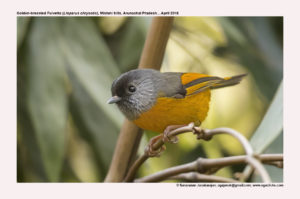
Golden-breasted Fulvetta Fulvetta lioparus chrysotis
Etymology:
- Fulvetta: Latin word derived from fulvus – tawny, yellowish-brown.
- Lioparus : Greek word leios -smooth; genus Parus – tit
- Chrysotis : Greek word khrusos gold; otis-eared.
Vernacular Names: Lepcha: Prong-samyer-pho
Distribution in India: Resident of Himalayas and Hills of North East India.
Description: Size of 10–11·5 cm; Wt. of 5–10 g. It is a colourful Fulvetta, blackish-grey above with silvery ear-coverts and orange-yellow underparts, wing flashes and outer tail. The male of nominate race has blackish lores, forehead, crown and supercilium, with paler bluish-grey in vague line down centre. The nape is bluish-grey, but more blackish at side. The upperparts are bluish-grey, more olive-tinged on back, rump and uppertail-coverts that are more yellow-olive and tipped paler. The uppertail is blackish, each feather having orange-yellow outer fringe on basal two-thirds. The upperwing-coverts are blackish, tertials are blackish with broad white inner fringes, flight-feathers are blackish on inner vanes but outer vanes of inner primaries are yellow and those of outer secondaries are orange-yellow forming double wing flash. The ear-coverts are silver-grey with darker shafts; chin and upper submoustachial area are blackish-grey, becoming bluish-grey on lower throat and behind ear-coverts. The underparts are bright orange-tinged yellow, deeper-toned across breast and flanks. The iris is hazel to brown; bill is pale bluish-plumbeous, with upper mandible orange basally. The legs are flesh-coloured to dull orange. The female is like male but may be paler orange-yellow. The juvenile has throat yellow. Race albilineatus has conspicuous white median crownstripe and richer colour overall, especially in intensity of orange coloration, blacker nape side, grey throat and submoustachial area with white feather tips.
Habitat:It is found in dense undergrowth, usually dominated by bamboo, in and adjacent to temperate forest. It is found at 2055–3050 m some descending to 1300 m in winter.
Food habits: It eats insects, small berries and seeds. It is found in pairs, or in small parties sometimes in association with other species, including other babblers, in mixed feeding flocks. It forages low down in thickets; often hangs upside-down in manner of a tit.
Breeding habits: They breed in May–Jun in India, May to Oct in Bhutan; Apr–Jun in Myanmar and China. The nest is constructed by both sexes, over 9–12 days. The nest is a very deep cup, sometimes domed or egg-shaped with side entrance, made of dry bamboo leaves, dry grasses, stalks and moss, often plastered with insect cocoons, lined with grass, moss roots, rootlets, animal hair and feathers, placed above ground in bamboo clump or bush. They lay a clutch of 3–5 eggs. The incubation period is 10–11 days. The nestling period is 11 days.